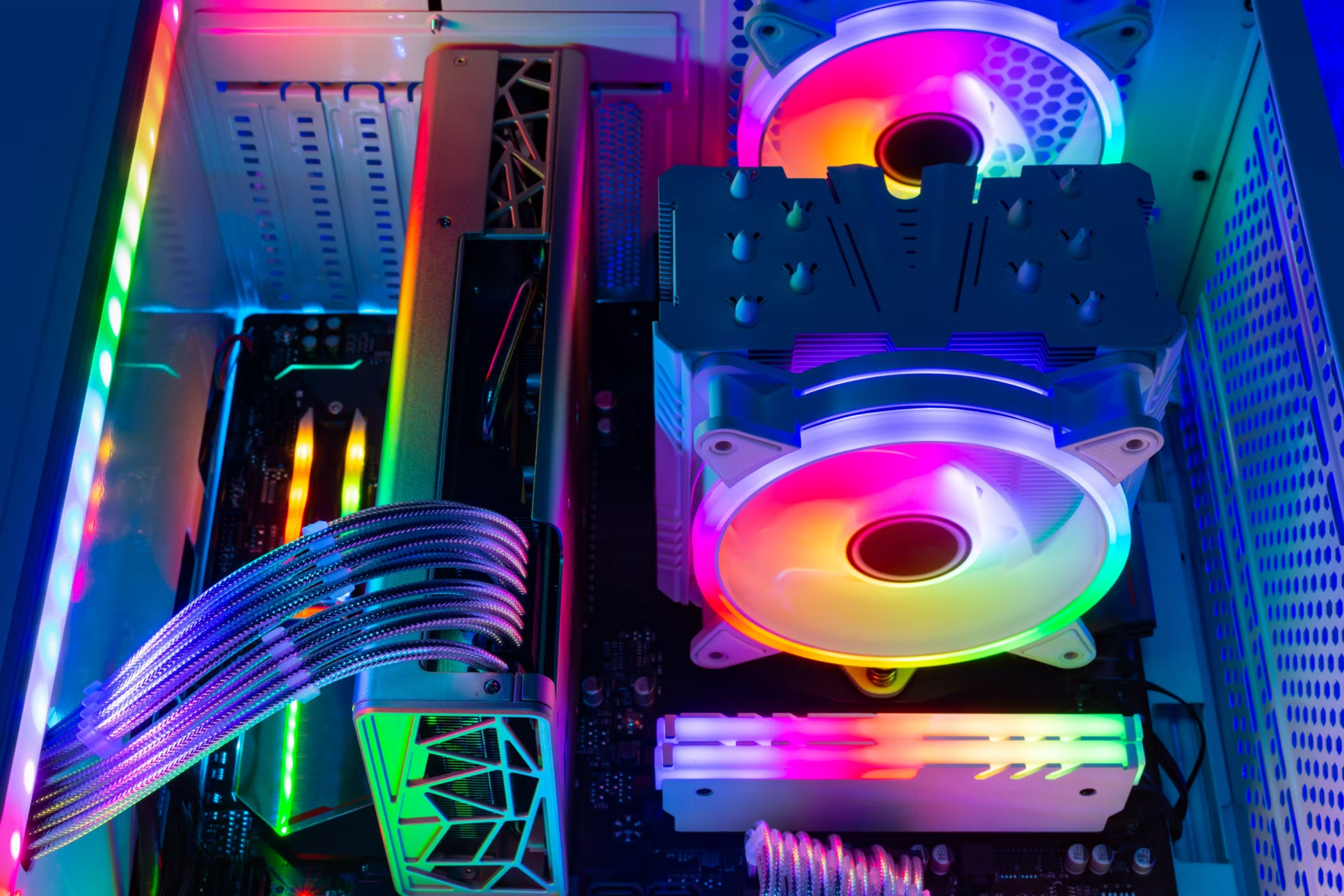The world of PC building has long been dominated by the allure of RGB lighting. From vibrant RAM sticks to glowing fans, enthusiasts have reveled in the ability to personalize their rigs with a symphony of colors. However, managing this symphony often required a cacophony of software – a problem addressed by Microsoft’s introduction of Windows Dynamic Lighting. Now, Asus, a leading motherboard manufacturer, is joining the movement, integrating native Windows Dynamic Lighting support into its latest motherboards. This integration promises a streamlined and user-friendly experience for PC builders seeking a more unified lighting experience.
Cutting the Cord on Bloatware: The Rise of Windows Dynamic Lighting
Anyone who has ventured into the world of RGB lighting knows the struggle. Different components often require dedicated software for control, leading to a cluttered desktop and a confusing user experience. Microsoft, in a bid to streamline this process, introduced Windows Dynamic Lighting with the Windows 11 2023H2 update. This feature leverages the open HID LampArray standard, allowing for native control of various RGB lighting devices directly from the Windows settings menu. This eliminates the need for multiple software applications and simplifies the process of synchronizing lighting effects across different components.

Asus Joins the Party: Seamless Integration for a Brighter Future
Asus, a company renowned for its innovative hardware solutions, has embraced Windows Dynamic Lighting with open arms. Their latest generation of motherboards, including the ROG Strix and TUF Gaming lines for AMD 600 and Intel 700 series processors, boast built-in support for this feature. This means users can ditch the bloatware and configure their motherboard’s RGB lighting directly from the familiar interface of Windows settings.
Here’s a breakdown of the benefits this integration brings to the table:
-
Simplified Control: Gone are the days of juggling multiple software programs. With Windows Dynamic Lighting, users can manage their motherboard’s RGB lighting alongside other peripherals directly from the Windows settings menu. This streamlined approach reduces clutter and simplifies the customization process.
-
Enhanced Compatibility: Windows Dynamic Lighting utilizes a standardized platform, ensuring seamless communication between the motherboard and the operating system. This eliminates compatibility issues that can sometimes arise when using manufacturer-specific software.
-
Unified Lighting Effects: Imagine seamlessly synchronizing the lighting on your motherboard, RAM, fans, and peripherals. Windows Dynamic Lighting facilitates this by allowing users to create unified lighting profiles that react dynamically to various events within the operating system. Picture your entire rig pulsating to the rhythm of your music or subtly changing colors based on system notifications.
-
Future-Proofing your Build: By embracing an industry standard, Asus is future-proofing its motherboards. As more peripherals adopt Windows Dynamic Lighting support, users can look forward to a more cohesive and integrated lighting experience across their entire PC setup.
Early Implementation: A Look at What’s to Come
While Asus’ initial implementation focuses on the latest motherboard models, it signifies a crucial step towards a more unified future for RGB lighting. The beta BIOS updates released by Asus currently cater to a select range of motherboards. However, it’s likely that future motherboard releases, as well as potential BIOS updates for older models, will include built-in Windows Dynamic Lighting support.
It’s important to note that this initial rollout is through beta BIOS updates. As with any beta software, there might be unforeseen bugs or compatibility issues. Users are advised to proceed with caution and only flash their BIOS if they are comfortable with the potential risks involved.
Beyond the Glowing Surface: The Potential Impact
The integration of Windows Dynamic Lighting in Asus motherboards goes beyond just aesthetics. It represents a shift towards a more standardized and user-friendly approach to RGB lighting. This bodes well for the future of PC building, potentially leading to:
-
Reduced Software Bloatware: With native Windows support, the reliance on manufacturer-specific software for RGB control could diminish. This can free up valuable system resources and eliminate unnecessary software bloatware.
-
A More Open Ecosystem: As more manufacturers embrace Windows Dynamic Lighting, we might see a more open ecosystem for RGB lighting control. This could lead to the development of third-party lighting profiles and customization tools, further enhancing user control and personalization options.
-
Streamlined Troubleshooting: Imagine encountering an issue with your RGB lighting. With Windows Dynamic Lighting, troubleshooting becomes simpler. The issue could potentially be addressed through Windows settings, eliminating the need to search for specific troubleshooting guides for individual manufacturer software.
A Glimmer of Hope in a Sea of Sameness
The PC building landscape can sometimes feel homogenous. While performance continues to improve, there’s a sense of visual uniformity among many builds. Asus’ decision to integrate Windows Dynamic Lighting in its latest motherboards injects a dose of welcome change. This move signifies a commitment to user-friendly customization and paves the way for a more streamlined future for RGB lighting in the PC building world
Early Adopter Reviews: Shining a Light on User Experience
While the official release of Windows Dynamic Lighting support in Asus motherboards is still in its early stages, some tech enthusiasts have taken the plunge and installed the beta BIOS updates. Here’s a glimpse into their initial experiences:
Positives:
-
Simplified Control is a Game Changer: Reviewers across the board have lauded the ease of use offered by Windows Dynamic Lighting. No longer wrestling with multiple software programs, users can now effortlessly adjust their motherboard’s RGB lighting directly through familiar Windows settings. This streamlined approach has been a major selling point for early adopters.
-
Compatibility is a Breath of Fresh Air: One of the biggest frustrations with traditional RGB lighting software is compatibility. Windows Dynamic Lighting, by leveraging a standardized platform, eliminates this issue. Early reviews confirm seamless communication between Asus motherboards and the operating system, ensuring smooth lighting control.
-
A Glimpse of Unified Lighting Potential: A few reviewers have experimented with syncing their motherboard lighting with other Windows Dynamic Lighting compatible peripherals. While the ecosystem is still nascent, the initial results have been promising. Imagine your entire PC setup pulsating in unison during a heated gaming session – a vision that Windows Dynamic Lighting is slowly bringing to life.
Cautions and Considerations:
-
Beta Blues: As expected with beta software, some users have encountered minor bugs and compatibility issues. These can range from occasional lighting glitches to conflicts with specific software configurations. While not widespread, these issues serve as a reminder that the technology is still under development.
-
Limited Motherboard Support (for Now): Currently, Windows Dynamic Lighting support is limited to specific Asus motherboard models via beta BIOS updates. This might leave some users feeling left out, especially those with older Asus motherboards. However, the hope is that future motherboard releases and potential BIOS updates for older models will address this limitation.
-
Learning Curve for Advanced Users: While Windows Dynamic Lighting simplifies control, some reviewers accustomed to the granular control offered by manufacturer-specific software expressed a slight learning curve. The new interface might require some tinkering to achieve their desired lighting effects. However, most agree that the overall ease of use outweighs this initial hurdle.
The Road Ahead: A Brighter Future for RGB Lighting?
The integration of Windows Dynamic Lighting in Asus motherboards marks a significant step towards a more streamlined and user-friendly approach to RGB lighting in PC building. While some challenges remain, including beta software teething issues and limited motherboard support initially, the potential benefits are undeniable.
Here’s a look at what the future might hold:
-
Industry-Wide Adoption: If Asus’ implementation proves successful, we might see other motherboard manufacturers follow suit, integrating Windows Dynamic Lighting support into their products. This would create a more standardized and user-friendly environment for RGB lighting enthusiasts across the board.
-
The Rise of Third-Party Tools: With a standardized platform like Windows Dynamic Lighting, the door opens for the development of powerful third-party tools. These tools could offer even more granular control over lighting effects, customization options, and deeper integration with games and other software.
-
A Brighter, More Unified Future: Imagine a future where all your RGB peripherals, from your motherboard to your RAM and fans, seamlessly work together, creating a unified lighting experience that reacts dynamically to your actions within the operating system. Windows Dynamic Lighting, with its focus on standardization and user-friendliness, paves the way for this exciting possibility.
Asus’ decision to embrace Windows Dynamic Lighting is a bold step towards a brighter future for RGB lighting in PC building. While the technology is still in its early stages, the potential benefits are undeniable. With wider adoption, streamlined control, and the potential for powerful third-party tools, Windows Dynamic Lighting has the potential to revolutionize the way we personalize and interact with our PC setups. The future of RGB lighting is looking bright, and Asus is at the forefront of this illuminating revolution.
















Add Comment